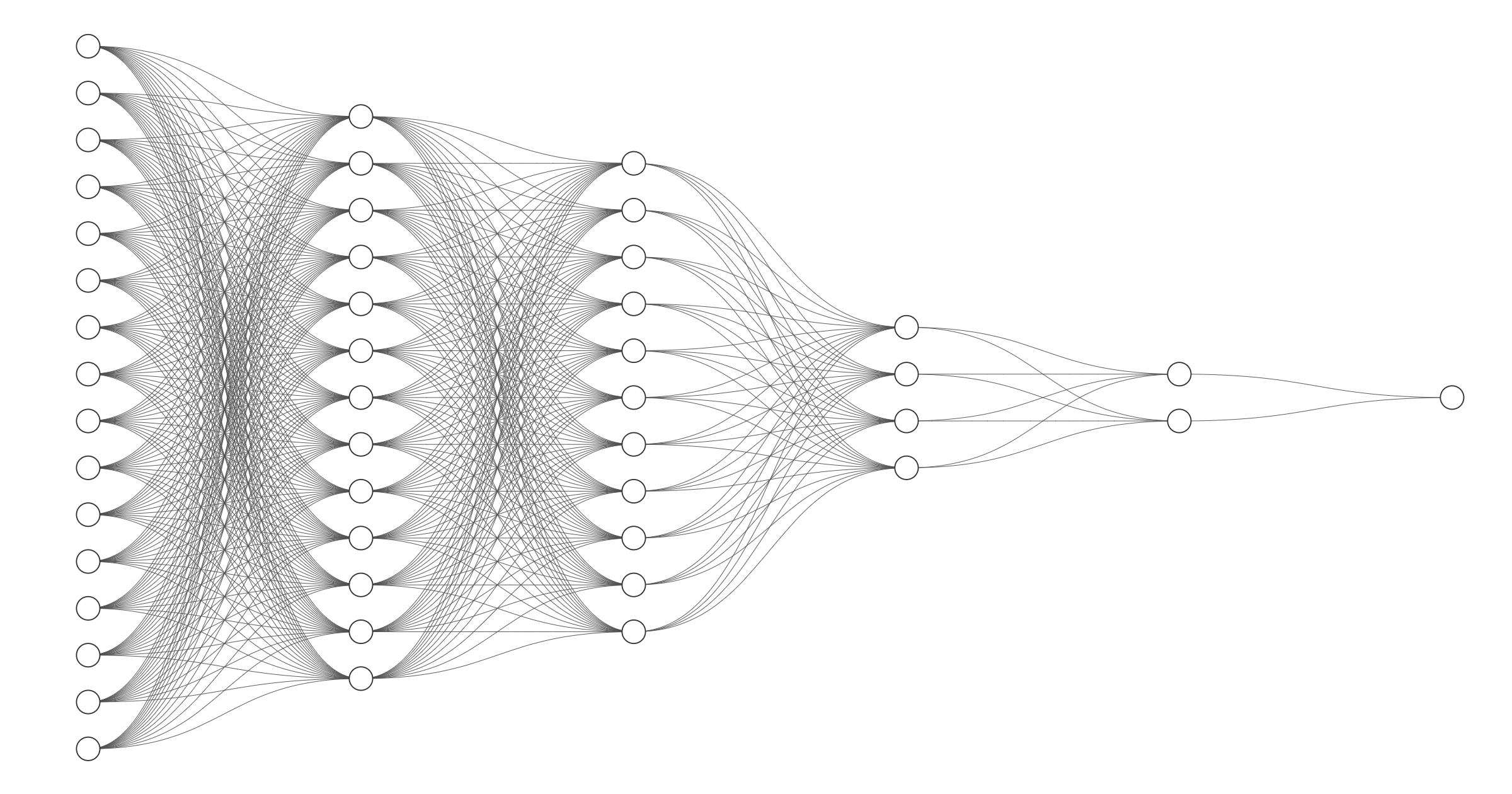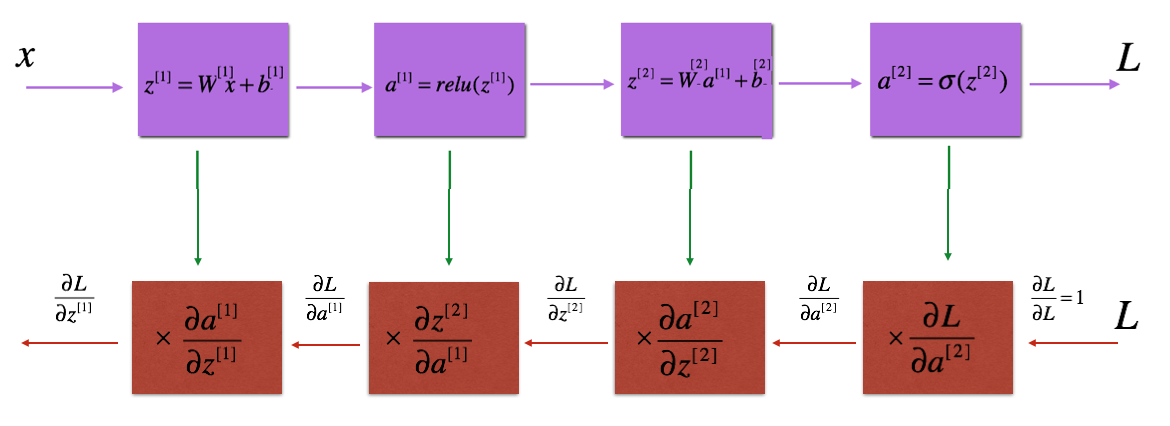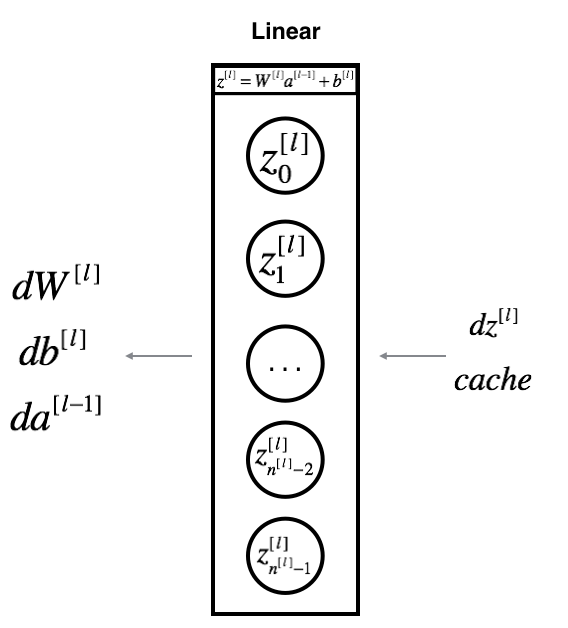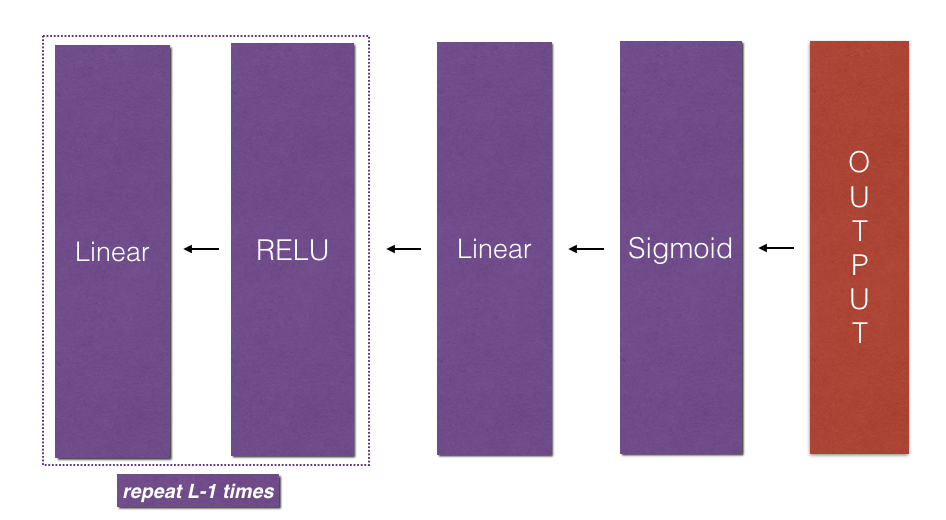Binary Classification Neural Network from Scratch
Packages
We first import necessary packages:
- numpy is the main package for scientific computing with Python.
- matplotlib is a library to plot graphs in Python.
- h5py is a Pythonic interface to the HDF5 binary data format.
1
2
3
4
5
6
7
8
9
10
11
12
13
import numpy as np
import h5py
import matplotlib.pyplot as plt
%matplotlib inline
plt.rcParams['figure.figsize'] = (5.0, 4.0) # set default size of plots
plt.rcParams['image.interpolation'] = 'nearest'
plt.rcParams['image.cmap'] = 'gray'
%load_ext autoreload # allows you to automatically reload Python modules (files)
# that have been modified without having to restart the Jupyter
# kernel
%autoreload 2 # all modules are reloaded before executing code
Sigmoid and ReLU
We first write some necessary functions we need in the later forward and backward propagation.
1
2
3
4
5
6
7
8
9
10
11
12
13
14
15
16
17
18
19
20
21
22
23
24
25
26
27
28
29
30
31
32
33
34
35
36
37
38
39
40
41
42
43
44
45
46
47
48
49
50
51
52
53
54
55
def sigmoid(Z):
# Implements the sigmoid activation in numpy
# Arguments:
# Z -- numpy array of any shape
# Returns:
# A -- output of sigmoid(z), same shape as Z
# cache -- returns Z as well, useful during backpropagation
A = 1/(1+np.exp(-Z))
cache = Z
return A, cache
def relu(Z):
# Implement the RELU function.
# Arguments:
# Z -- Output of the linear layer, of any shape
# Returns:
# A -- Post-activation parameter, of the same shape as Z
# cache -- a python dictionary containing "A" ; stored for computing the backward pass efficiently
A = np.maximum(0,Z)
cache = Z
return A, cache
def relu_backward(dA, cache):
# Implement the backward propagation for a single RELU unit.
# Arguments:
# dA -- post-activation gradient, of any shape
# cache -- 'Z' where we store for computing backward propagation efficiently
# Returns:
# dZ -- Gradient of the cost with respect to Z
Z = cache
dZ = np.array(dA, copy=True) # just converting dz to a correct object.
# When z <= 0, you should set dz to 0 as well.
dZ[Z <= 0] = 0
return dZ
def sigmoid_backward(dA, cache):
# Implement the backward propagation for a single SIGMOID unit.
# Arguments:
# dA -- post-activation gradient, of any shape
# cache -- 'Z' where we store for computing backward propagation efficiently
# Returns:
# dZ -- Gradient of the cost with respect to Z
Z = cache
s = 1/(1+np.exp(-Z))
dZ = dA * s * (1-s)
return dZ
Note:
For every forward function, there is a corresponding backward function. This is why at every step of the forward module we will be storing some values in a cache. These cached values are useful for computing gradients.
Outline
Notation:
- Superscript $[l]$ denotes a quantity associated with the $l^{th}$ layer.
- Example: $a^{[L]}$ is the $L^{th}$ layer activation. $W^{[L]}$ and $b^{[L]}$ are the $L^{th}$ layer parameters.
- Superscript $(i)$ denotes a quantity associated with the $i^{th}$ example.
- Example: $x^{(i)}$ is the $i^{th}$ training example.
- Lowerscript $i$ denotes the $i^{th}$ entry of a vector.
- Example: $a^{[l]}_i$ denotes the $i^{th}$ entry of the $l^{th}$ layer’s activations.
Here is the outline of this project:
- Initialize the parameters for a two-layer network and for an $L$-layer neural network
- Implement the forward propagation module (shown in purple in the figure below)
- Complete the LINEAR part of a layer’s forward propagation step (resulting in $Z^{[l]}$)
- Use ReLU/Sigmoid as the activation functions.
- Combine the previous two steps into a new [LINEAR->ACTIVATION] forward function.
- Stack the [LINEAR->RELU] forward function L-1 time (for layers 1 through L-1) and add a [LINEAR->SIGMOID] at the end (for the final layer $L$). This gives you a new L_model_forward function.
- Compute the loss
- Implement the backward propagation module (denoted in red in the figure below)
- Complete the LINEAR part of a layer’s backward propagation step
- USe relu_backward/sigmoid_backward to compute gradient of the activation functions
- Combine the previous two steps into a new [LINEAR->ACTIVATION] backward function
- Stack [LINEAR->RELU] backward L-1 times and add [LINEAR->SIGMOID] backward in a new L_model_backward function
- Update the parameters using gradient descent
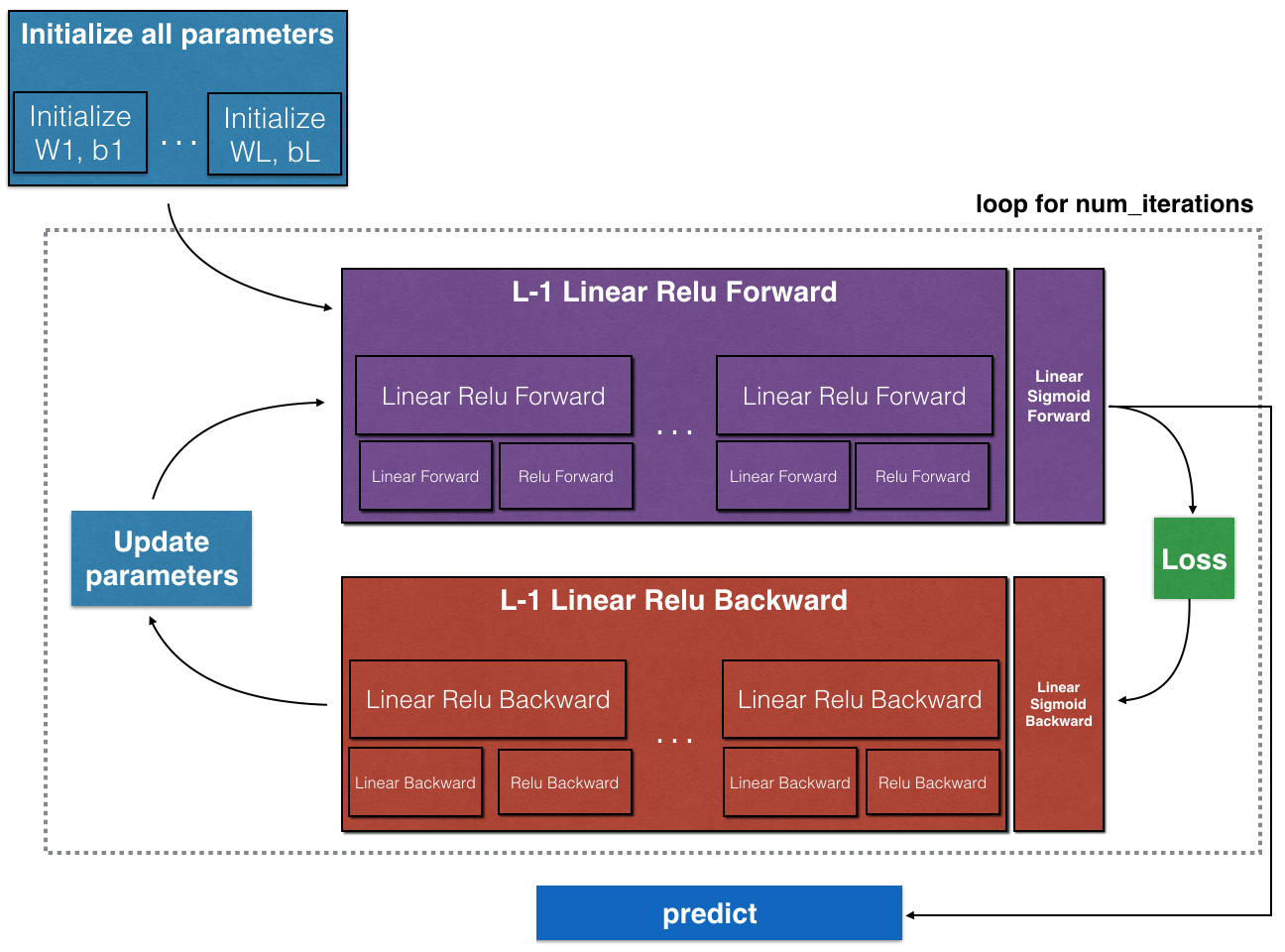
Initialisation
Create and initialise the parameters of the 2-layer neural network with structure LINEAR -> RELU -> LINEAR -> SIGMOID.
1
2
3
4
5
6
7
8
9
10
11
12
13
14
15
16
17
18
19
20
21
22
23
24
25
26
def initialize_parameters(n_x, n_h, n_y):
# Argument:
# n_x -- size of the input layer
# n_h -- size of the hidden layer
# n_y -- size of the output layer
# Returns:
# parameters -- python dictionary containing your parameters:
# W1 -- weight matrix of shape (n_h, n_x)
# b1 -- bias vector of shape (n_h, 1)
# W2 -- weight matrix of shape (n_y, n_h)
# b2 -- bias vector of shape (n_y, 1)
W1 = np.random.randn(n_h, n_x) * 0.01
b1 = np.zeros((n_h, 1))
W2 = np.random.randn(n_y, n_h) * 0.01
b2 = np.zeros((n_y, 1))
parameters = {"W1": W1,
"b1": b1,
"W2": W2,
"b2": b2}
return parameters
Let’s then initialise the parameters of an $L$-layer neural network with structure [LINEAR -> RELU] $\times$ (L-1) -> LINEAR -> SIGMOID.
1
2
3
4
5
6
7
8
9
10
11
12
13
14
15
16
17
18
def initialize_parameters_deep(layer_dims):
# Arguments:
# layer_dims -- python array (list) containing the dimensions of each layer in our network
# Returns:
# parameters -- python dictionary containing your parameters "W1", "b1", ..., "WL", "bL":
# Wl -- weight matrix of shape (layer_dims[l], layer_dims[l-1])
# bl -- bias vector of shape (layer_dims[l], 1)
parameters = {}
L = len(layer_dims) # number of layers in the network including the input layer
for l in range(1, L):
parameters['W' + str(l)] = np.random.randn(layer_dims[l], layer_dims[l-1]) * 0.01
parameters['b' + str(l)] = np.zeros((layer_dims[l], 1))
return parameters
Forward Propagation
To do implement the forward propagation module properly, let’s write $3$ functions respectively to do the following:
- LINEAR
- LINEAR -> ACTIVATION where ACTIVATION will be either ReLU or Sigmoid.
- [LINEAR -> RELU] $\times$ (L-1) -> LINEAR -> SIGMOID (whole model)
Linear Forward
The linear forward module (vectorized over all the examples) computes the following equations:
\[Z^{[l]} = W^{[l]}A^{[l-1]} +b^{[l]}\]where $A^{[0]} = X$.
1
2
3
4
5
6
7
8
9
10
11
12
13
14
def linear_forward(A, W, b):
# Implement the linear part of a layer's forward propagation.
# Arguments:
# A -- activations from previous layer (or input data): (size of previous layer, number of examples)
# W -- weights matrix: numpy array of shape (size of current layer, size of previous layer)
# b -- bias vector, numpy array of shape (size of the current layer, 1)
# Returns:
# Z -- the input of the activation function, also called pre-activation parameter
# cache -- a python tuple containing "A", "W" and "b" ; stored for computing the backward pass efficiently
Z = W @ A + b
cache = (A, W, b)
return Z, cache
Linear Activation Forward
In this project, we only use 2 activation functions:
- Sigmoid: $\sigma(Z) = \sigma(W A + b) = \frac{1}{ 1 + e^{-(W A + b)}}$.
1
A, activation_cache = sigmoid(Z)
- ReLU: The mathematical formula for ReLu is $A = RELU(Z) = max(0, Z)$.
1
A, activation_cache = relu(Z)
Now we implement the forward propagation of the LINEAR->ACTIVATION layer. Mathematically, $A^{[l]} = g(Z^{[l]}) = g(W^{[l]}A^{[l-1]} +b^{[l]})$ where the activation “g” can be sigmoid() or relu().
1
2
3
4
5
6
7
8
9
10
11
12
13
14
15
16
17
18
19
20
21
22
23
24
def linear_activation_forward(A_prev, W, b, activation):
# Implement the forward propagation for the LINEAR->ACTIVATION layer
# Arguments:
# A_prev -- activations from previous layer (or input data): (size of previous layer, number of examples)
# W -- weights matrix: numpy array of shape (size of current layer, size of previous layer)
# b -- bias vector, numpy array of shape (size of the current layer, 1)
# activation -- the activation to be used in this layer, stored as a text string: "sigmoid" or "relu"
# Returns:
# A -- the output of the activation function, also called the post-activation value
# cache -- a python tuple containing "linear_cache" and "activation_cache";
# stored for computing the backward pass efficiently
if activation == "sigmoid":
Z, linear_cache = linear_forward(A_prev, W, b)
A, activation_cache = sigmoid(Z)
elif activation == "relu":
Z, linear_cache = linear_forward(A_prev, W, b)
A, activation_cache = relu(Z)
cache = (linear_cache, activation_cache)
return A, cache
L Model Forward
It is time to put the above 2 functions together to implement the entire forward module. Mathematically, the variable AL will denote $A^{[L]} = \sigma(Z^{[L]}) = \sigma(W^{[L]} A^{[L-1]} + b^{[L]})$, where $\sigma$ stands for the sigmoid function.
1
2
3
4
5
6
7
8
9
10
11
12
13
14
15
16
17
18
19
20
21
22
23
24
25
26
27
28
def L_model_forward(X, parameters):
# Implement forward propagation for the [LINEAR->RELU]*(L-1)->LINEAR->SIGMOID computation
# Arguments:
# X -- data, numpy array of shape (input size, number of examples)
# parameters -- output of initialize_parameters_deep()
# Returns:
# AL -- activation value from the output (last) layer
# caches -- list of caches containing:
# every cache of linear_activation_forward() (there are L of them, indexed from 0 to L-1)
caches = []
A = X
L = len(parameters) // 2 # number of layers in the neural network
# Implement [LINEAR -> RELU]*(L-1). Add "cache" to the "caches" list.
# The for loop starts at 1 because layer 0 is the input
for l in range(1, L):
A_prev = A
A, cache = linear_activation_forward(A_prev, parameters["W" + str(l)], parameters["b" + str(l)], 'relu')
caches.append(cache)
# Implement LINEAR -> SIGMOID. Add "cache" to the "caches" list.
AL, cache = linear_activation_forward(A, parameters["W" + str(L)], parameters["b" + str(L)],'sigmoid')
caches.append(cache)
return AL, caches
Cost Function
We’ve implemented a full forward propagation that takes the input X and outputs a row vector $A^{[L]}$ containing the predictions. It also records all intermediate values in “caches”. Now we use $A^{[L]}$ to compute the cost of the predictions. This is straightforward as long as we are familiar with the formula of the logistic cost function.
The cost function is computed as
\[-\frac{1}{m} \sum\limits_{i = 1}^{m} \left[y^{(i)}\log\left(a^{[L] (i)}\right) + (1-y^{(i)})\log\left(1- a^{[L](i)}\right)\right].\]1
2
3
4
5
6
7
8
9
10
11
12
13
14
15
def compute_cost(AL, Y):
# Implement the cost function defined by equation (7).
# Arguments:
# AL -- probability vector corresponding to your label predictions, shape (1, number of examples)
# Y -- true "label" vector (for example: containing 0 if non-cat, 1 if cat), shape (1, number of examples)
# Returns:
# cost -- cross-entropy cost
m = Y.shape[1]
cost = -1/m * np.sum(Y*np.log(AL) + (1-Y)*np.log(1-AL))
cost = np.squeeze(cost) # To make sure cost's shape is what we expect (e.g. this turns [[1]] into 1).
return cost
Backward Propagation
Now, similarly to forward propagation, we build the backward propagation in three steps:
- LINEAR backward
- LINEAR -> ACTIVATION backward where ACTIVATION computes the derivative of either the ReLU or sigmoid activation
- [LINEAR -> RELU] $\times$ (L-1) -> LINEAR -> SIGMOID backward (whole model)
Linear Backward
Suppose we have already calculated the derivative $dZ^{[l]} = \frac{\partial \mathcal{L} }{\partial Z^{[l]}}$. We want to get $(dW^{[l]}, db^{[l]}, dA^{[l-1]})$. The three outputs $(dW^{[l]}, db^{[l]}, dA^{[l-1]})$ are computed using the input $dZ^{[l]}$.
Here are the formulas: \(dW^{[l]} = \frac{\partial \mathcal{J} }{\partial W^{[l]}} = \frac{1}{m} dZ^{[l]} A^{[l-1] T} \tag{8}\) \(db^{[l]} = \frac{\partial \mathcal{J} }{\partial b^{[l]}} = \frac{1}{m} \sum_{i = 1}^{m} dZ^{[l](i)}\tag{9}\) \(dA^{[l-1]} = \frac{\partial \mathcal{L} }{\partial A^{[l-1]}} = W^{[l] T} dZ^{[l]} \tag{10}\)
$A^{[l-1] T}$ is the transpose of $A^{[l-1]}$.
Note:
- axis=1 or axis=0 specify if the sum is carried out by rows or by columns respectively.
- keepdims specifies if the original dimensions of the matrix must be kept.
1
2
3
4
5
6
7
8
9
10
11
12
13
14
15
16
17
18
19
20
21
def linear_backward(dZ, cache):
# Implement the linear portion of backward propagation for a single layer (layer l)
# Arguments:
# dZ -- Gradient of the cost with respect to the linear output (of current layer l)
# cache -- tuple of values (A_prev, W, b) coming from the forward propagation in the current layer
# Returns:
# dA_prev -- Gradient of the cost with respect to the activation (of the previous layer l-1), same shape as A_prev
# dW -- Gradient of the cost with respect to W (current layer l), same shape as W
# db -- Gradient of the cost with respect to b (current layer l), same shape as b
A_prev, W, b = cache
m = A_prev.shape[1]
dW = 1/m * dZ @ A_prev.T
db = 1/m * np.sum(dZ, axis = 1, keepdims = True)
dA_prev = W.T @ dZ
return dA_prev, dW, db
Linear Activation Backward
Implement the backpropagation for the LINEAR->ACTIVATION layer. We already have the following 2 functions:
sigmoid_backward: Implements the backward propagation for SIGMOID unit.
1
dZ = sigmoid_backward(dA, activation_cache)
relu_backward: Implements the backward propagation for RELU unit.
1
dZ = relu_backward(dA, activation_cache)
If $g(.)$ is the activation function, sigmoid_backward and relu_backward compute
1
2
3
4
5
6
7
8
9
10
11
12
13
14
15
16
17
18
19
20
21
22
23
24
25
def linear_activation_backward(dA, cache, activation):
# Implement the backward propagation for the LINEAR->ACTIVATION layer.
# Arguments:
# dA -- post-activation gradient for current layer l
# cache -- tuple of values (linear_cache, activation_cache) we store for computing backward propagation efficiently
# activation -- the activation to be used in this layer, stored as a text string: "sigmoid" or "relu"
# Returns:
# dA_prev -- Gradient of the cost with respect to the activation (of the previous layer l-1), same shape as A_prev
# dW -- Gradient of the cost with respect to W (current layer l), same shape as W
# db -- Gradient of the cost with respect to b (current layer l), same shape as b
linear_cache, activation_cache = cache
if activation == "relu":
dZ = relu_backward(dA, activation_cache)
dA_prev, dW, db = linear_backward(dZ, linear_cache)
elif activation == "sigmoid":
dZ = sigmoid_backward(dA, activation_cache)
dA_prev, dW, db = linear_backward(dZ, linear_cache)
return dA_prev, dW, db
L Model Backward
Now we implement backpropagation for the [LINEAR->RELU] $\times$ (L-1) -> LINEAR -> SIGMOID model.
Recall that when we implemented the L_model_forward function, at each iteration, we stored a cache which contains (X,W,b, and z). In the back propagation module, we use those variables to compute the gradients. Therefore, in the L_model_backward function, we iterate through all the hidden layers backward, starting from layer $L$. On each step, we use the cached values for layer $l$ to backpropagate through layer $l$. The figure below shows the backward pass.
1
2
3
4
5
6
7
8
9
10
11
12
13
14
15
16
17
18
19
20
21
22
23
24
25
26
27
28
29
30
31
32
33
34
35
36
37
38
39
40
41
def L_model_backward(AL, Y, caches):
# Implement the backward propagation for the [LINEAR->RELU] * (L-1) -> LINEAR -> SIGMOID group
# Arguments:
# AL -- probability vector, output of the forward propagation (L_model_forward())
# Y -- true "label" vector (containing 0 if non-cat, 1 if cat)
# caches -- list of caches containing:
# every cache of linear_activation_forward() with "relu" (it's caches[l], for l in range(L-1) i.e l = 0...L-2)
# the cache of linear_activation_forward() with "sigmoid" (it's caches[L-1])
# Returns:
# grads -- A dictionary with the gradients
# grads["dA" + str(l)] = ...
# grads["dW" + str(l)] = ...
# grads["db" + str(l)] = ...
grads = {}
L = len(caches) # the number of layers
m = AL.shape[1]
Y = Y.reshape(AL.shape) # after this line, Y is the same shape as AL
dAL = - (np.divide(Y, AL) - np.divide(1 - Y, 1 - AL)) # derivative of cost with respect to AL
# Lth layer (SIGMOID -> LINEAR) gradients. Inputs: "dAL, current_cache". Outputs: "grads["dAL-1"], grads["dWL"], grads["dbL"]
current_cache = caches[L - 1]
dA_prev_temp, dW_temp, db_temp = linear_activation_backward(dAL, current_cache, 'sigmoid')
grads["dA" + str(L-1)] = dA_prev_temp
grads["dW" + str(L)] = dW_temp
grads["db" + str(L)] = db_temp
# Loop from l=L-2 to l=0
for l in reversed(range(L-1)):
# lth layer: (RELU -> LINEAR) gradients.
# Inputs: "grads["dA" + str(l + 1)], current_cache". Outputs: "grads["dA" + str(l)] , grads["dW" + str(l + 1)] , grads["db" + str(l + 1)]
current_cache = caches[l]
dA_prev_temp, dW_temp, db_temp = linear_activation_backward(grads["dA" + str(L-1)], current_cache, 'relu')
grads["dA" + str(l)] = dA_prev_temp
grads["dW" + str(l + 1)] = dW_temp
grads["db" + str(l + 1)] = db_temp
return grads
Update Parameters
To update the parameters of the model, we use the basic version of gradient descent:
\[W^{[l]} = W^{[l]} - \alpha \text{ } dW^{[l]},\] \[b^{[l]} = b^{[l]} - \alpha \text{ } db^{[l]},\]where $\alpha$ is the learning rate.
After computing the updated parameters, we store them in the parameters dictionary.
1
2
3
4
5
6
7
8
9
10
11
12
13
14
15
16
17
18
19
20
21
22
def update_parameters(params, grads, learning_rate):
# Update parameters using gradient descent
# Arguments:
# params -- python dictionary containing your parameters
# grads -- python dictionary containing your gradients, output of L_model_backward
# Returns:
# parameters -- python dictionary containing your updated parameters
# parameters["W" + str(l)] = ...
# parameters["b" + str(l)] = ...
parameters = params.copy()
L = len(parameters) // 2 # number of layers in the neural network
# Update rule for each parameter. Use a for loop.
for l in range(L):
parameters["W" + str(l + 1)] = parameters["W" + str(l + 1)] - learning_rate * grads["dW" + str(l + 1)]
parameters["b" + str(l + 1)] = parameters["b" + str(l + 1)] - learning_rate * grads["db" + str(l + 1)]
return parameters
We are done! (In fact, not quite done yet. I will modify it later when I feel productive…) You can see an application of classifying cat vs non-cat images in this github repo.
